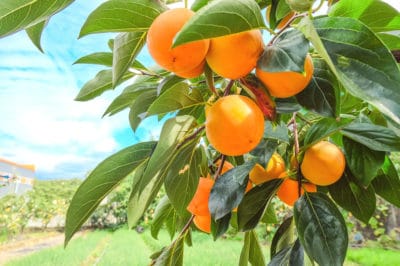Oriental Persimmon Trees
- Oriental persimmon trees (Diospyros kaki) have been cultivated in Japan and Korea since the 8th century and in China for thousands of years before that.
- Growers have hybridized more than 2 thousand Oriental persimmon cultivars.
- The first Oriental persimmon trees arrived in California in 1870s. New varieties were imported over the next 50 years.
- Today, all commercial U.S. persimmons grow on 3 thousand acres in the San Joaquin Valley (USDA plant hardiness zones 8 through 10).
- Brazil and Italy are also major producers of Oriental persimmons. Australia, New Zealand, Spain, Chile and Egypt are minor ones.
- Only two Oriental persimmons, ‘Hiyachi’ and ‘Fuyu,’ account for the persimmons marketed in the United States.
- ‘Hiyachi’ produces tomato-red, acorn-shaped fruit that’s sweet only when extremely ripe.
- ‘Fuyu’ has squat, round, pumpkin-colored fruit sweet enough to eat while still crisp and firm. Its taste hints of dates and pears with a touch of cinnamon.
American Persimmon Trees
- American persimmon trees (Diospyros virginiana) grow wild across the eastern United States from New England to Kansas and Texas and south to Florida (USDA zones 4 through 9).
- Native Americans cultivated the trees for centuries, using the fruit in pudding, cornbread and gruel.
- American persimmon fruit falls to the ground when ripe. If you have to pull it from the tree, it’s too astringent to eat.
- The ripe fruit is round, bright orange and up to 2 inches in diameter.
- Deer find the ripe fruit’s jellylike texture and amaretto flavor irresistible.
- Because the fruit is too soft for long-distance shipping, American persimmon trees aren’t commercialized. Japanese cultivars, however, are grafted onto their rootstocks.
More than Just Fruit Trees
As alternate-bearing trees, persimmons usually follow an abundantly fruiting season with a sparsely fruiting one. Their other features, however, make the “lean” years much easier to accept:
- Persimmons’ drooping branches of glossy, deep-green summer leaves give them a faintly tropical appearance.
- The leaves change to striking shades of yellow, orange or crimson in fall, just as their pumpkin-hued fruit ripens.
- Dried Oriental persimmon leaves make a tea rich in Vitamin C, magnesium, and digestion-aiding tannins.
- Even in winter, all persimmons enhance their surroundings with deeply furrowed, black bark resembling alligator skin.
Finally, as members of the Ebony (Ebenaceae) family, persimmon trees have fine-grained, black heartwood strong enough for use in golf clubs, pool cues, drumsticks and even flooring.
